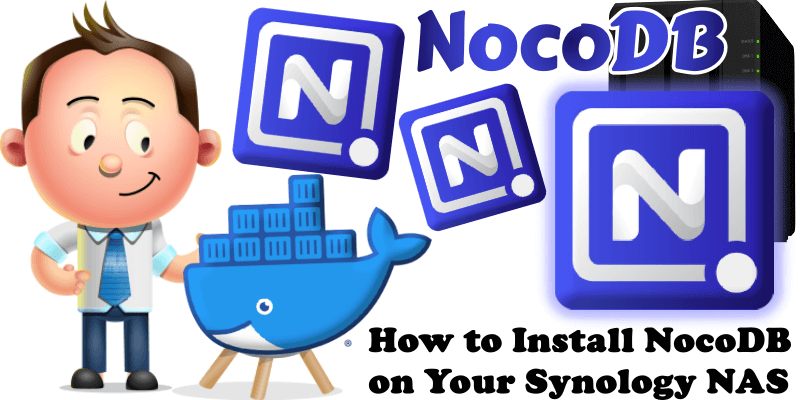
NocoDB is an open source #NoCode platform that turns any MySQL, PostgreSQL, SQL Server, SQLite & MariaDB into a smart-spreadsheet. NocoDB is so flexible that it can be integrated with many business verticals. NocoDB has been downloaded more than 6.6 million times in Docker within the first year of launch alone. NocoDB allows even non-developers or business users to become software creators. In this step by step guide I will show you how to install NocoDB on your Synology NAS using Docker.
STEP 1
Please Support My work by Making a Donation.
STEP 2
Install Portainer using my step by step guide. If you already have Portainer installed on your Synology NAS, skip this STEP. Attention: Make sure you have installed the latest Portainer version.
STEP 3
Make sure you have a synology.me Wildcard Certificate. Follow my guide to get a Wildcard Certificate. If you already have a synology.me Wildcard certificate, skip this STEP.
STEP 4
Go to Control Panel / Login Portal / Advanced Tab / click Reverse Proxy. Follow the instructions in the image below.
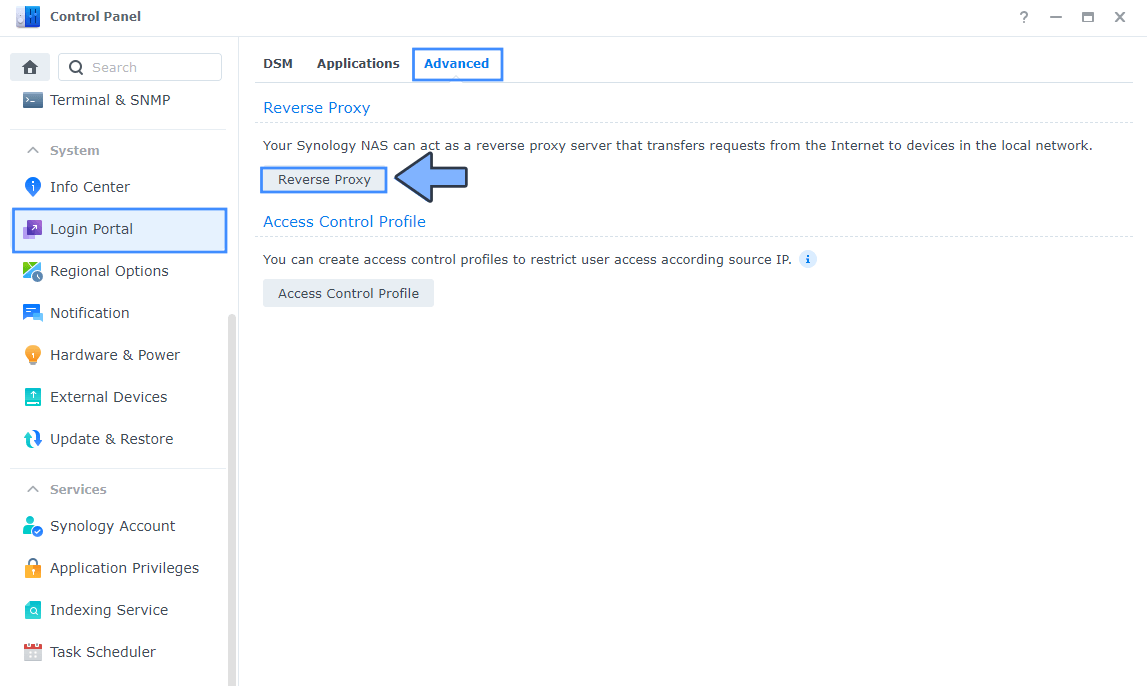
STEP 5
Now click the “Create” button. Follow the instructions in the image below.
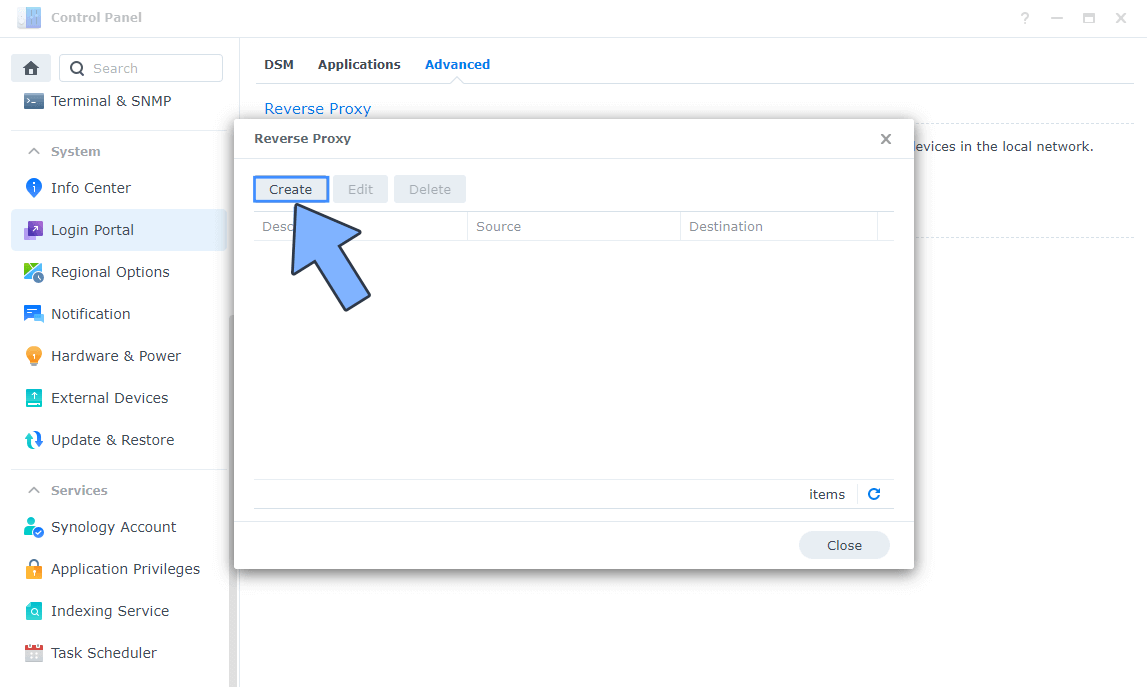
STEP 6
After you click the Create button, the window below will open. Follow the instructions in the image below.
On the General area, set the Reverse Proxy Name description: type in NocoDB. After that, add the following instructions:
Source:
Protocol: HTTPS
Hostname: nocodb.yourname.synology.me
Port: 443
Check Enable HSTS
Destination:
Protocol: HTTP
Hostname: localhost
Port: 8631

STEP 7
On the Reverse Proxy Rules, click the Custom Header tab. Click Create and then, from the drop-down menu, click WebSocket. After you click on WebSocket, two Header Names and two Values will be automatically added. Click Save. Follow the instructions in the image below.

STEP 8
Go to Control Panel / Network / Connectivity tab/ Check Enable HTTP/2 then click Apply. Follow the instructions in the image below.
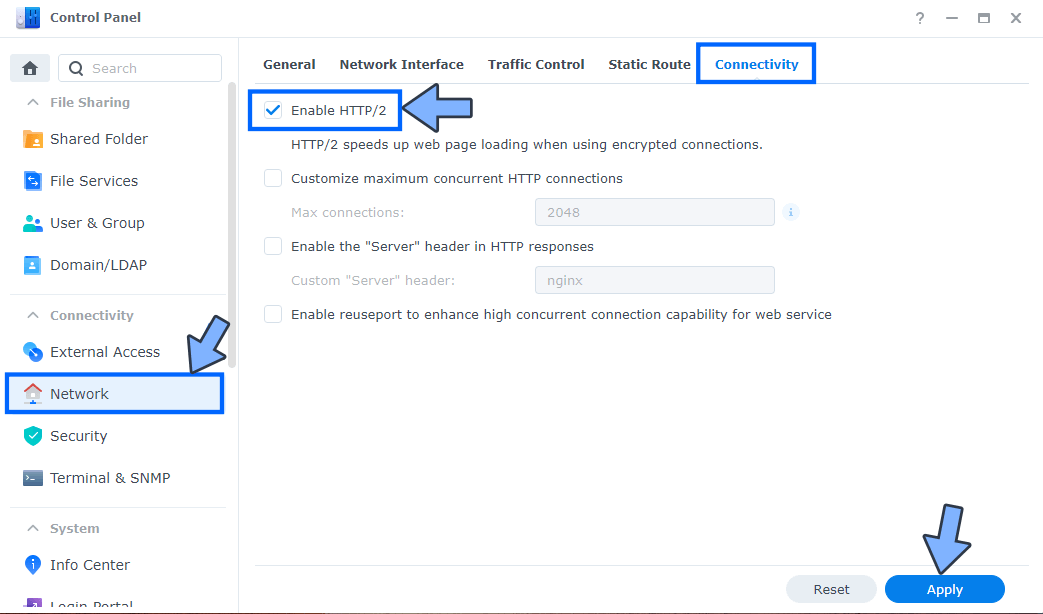
STEP 9
Go to Control Panel / Security / Advanced tab/ Check Enable HTTP Compression then click Apply. Follow the instructions in the image below.
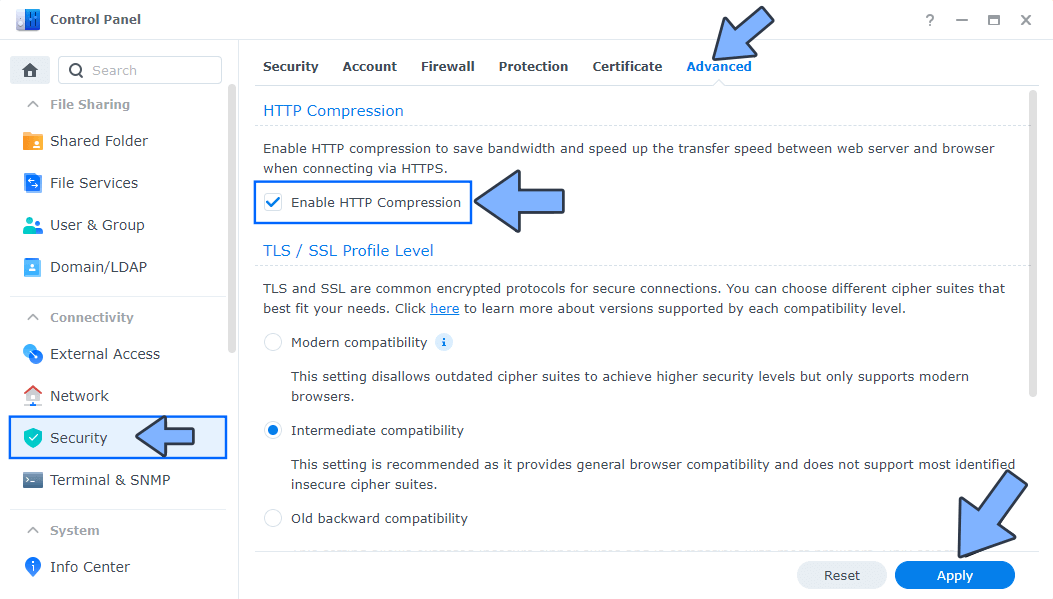
STEP 10
Go to File Station and open the docker folder. Inside the docker folder, create one new folder and name it nocodb. Follow the instructions in the image below.
Note: Be careful to enter only lowercase, not uppercase letters.
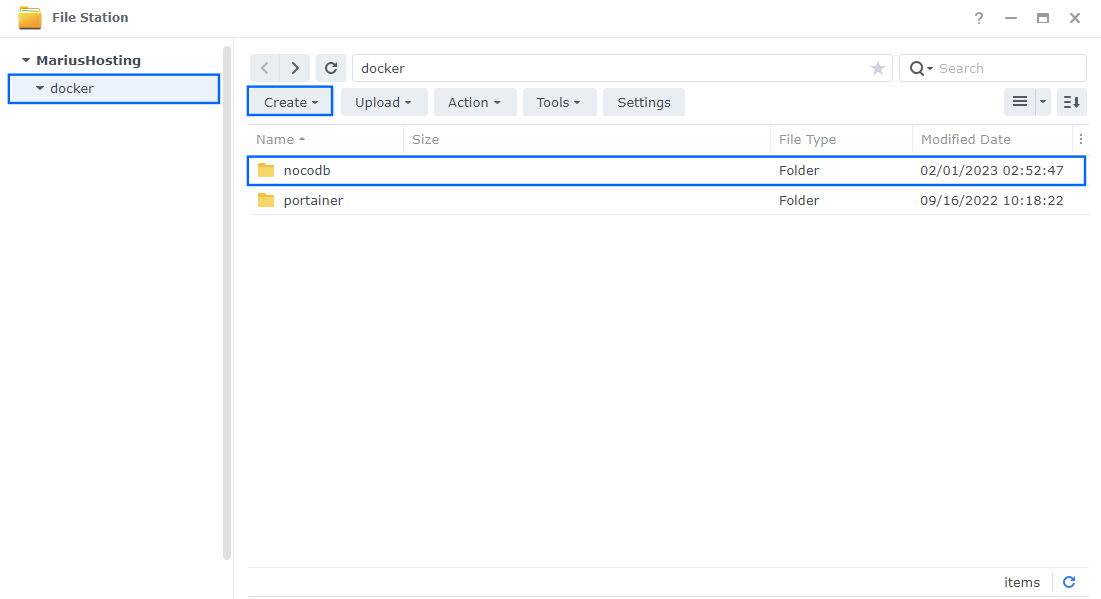
STEP 11
Now create two new folders inside the nocodb folder that you have previously created at STEP 10 and name them data and db. Follow the instructions in the image below.
Note: Be careful to enter only lowercase, not uppercase letters.
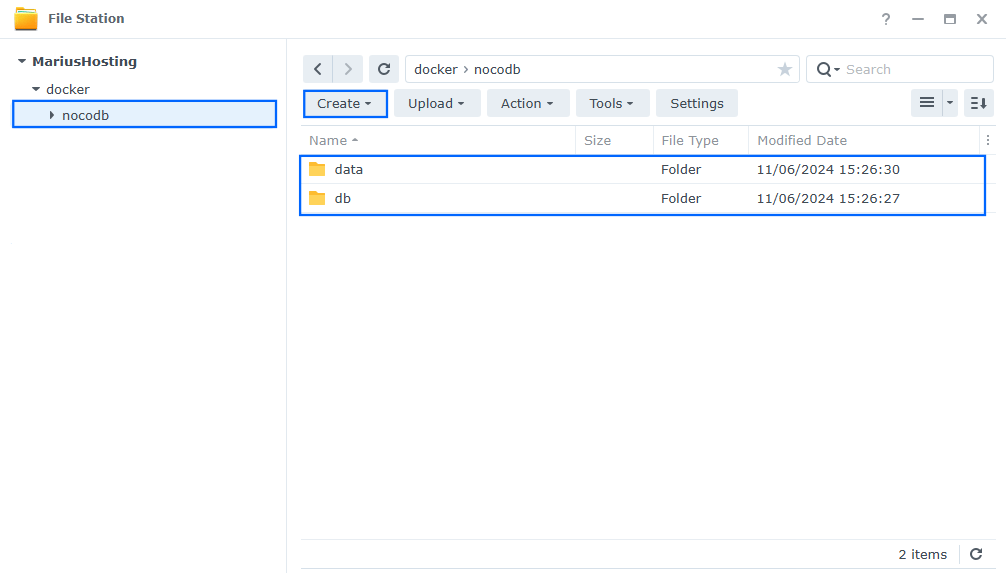
STEP 12
Right click on the nocodb folder that you have previously created at STEP 10 then click Properties. Follow the instructions in the image below.
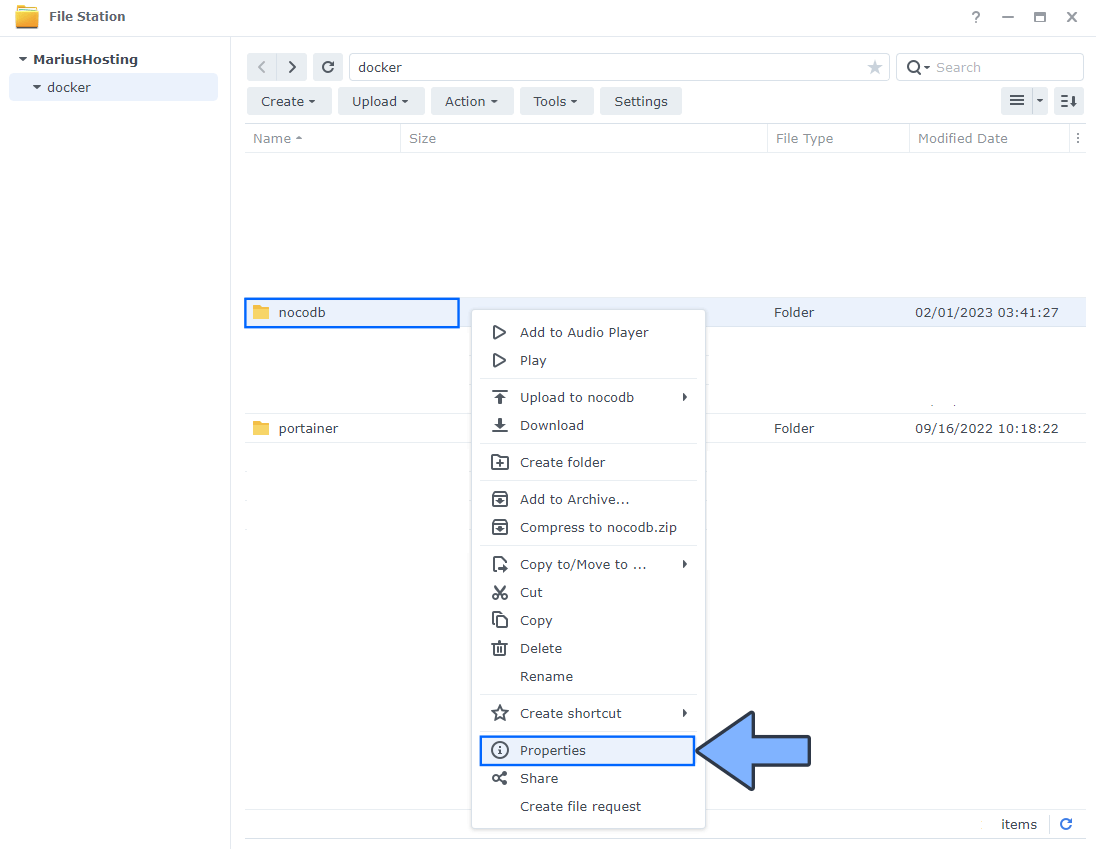
STEP 13
Go to the Permission tab, then click Advanced options. From the drop-down menu, choose “Make inherited permissions explicit“. Follow the instructions in the image below.

STEP 14
Select Everyone then click the Edit tab. Follow the instructions in the image below.
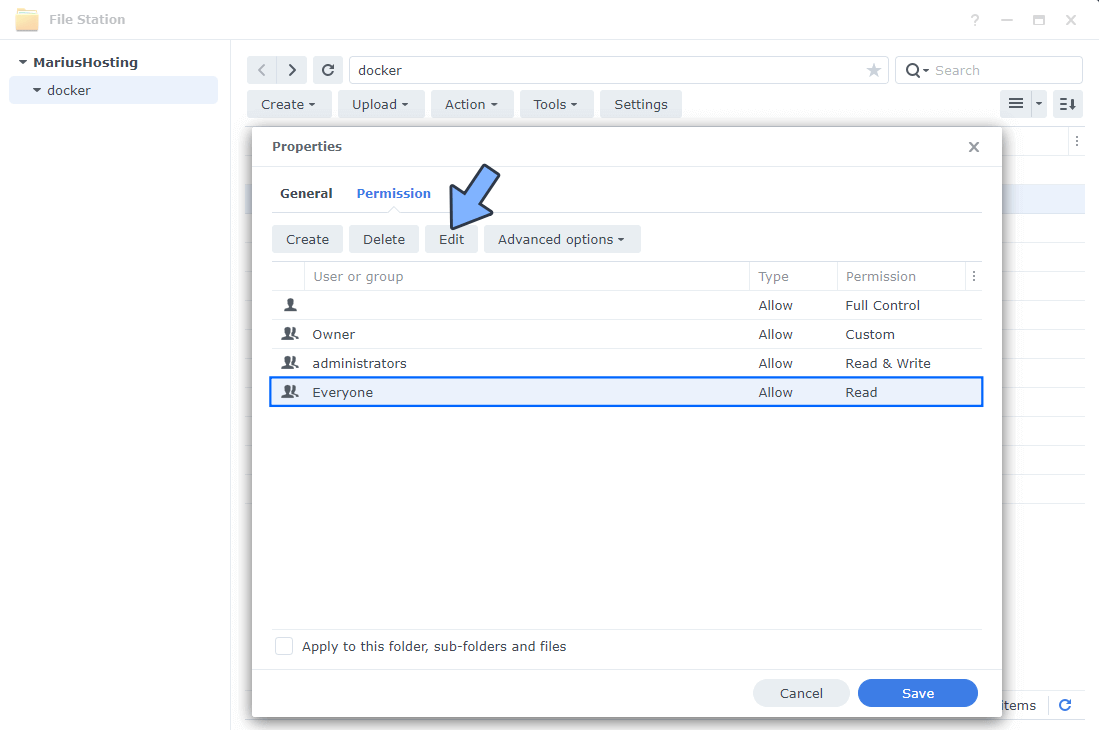
STEP 15
Check all Read and Write Permissions. Click Done. Follow the instructions in the image below.
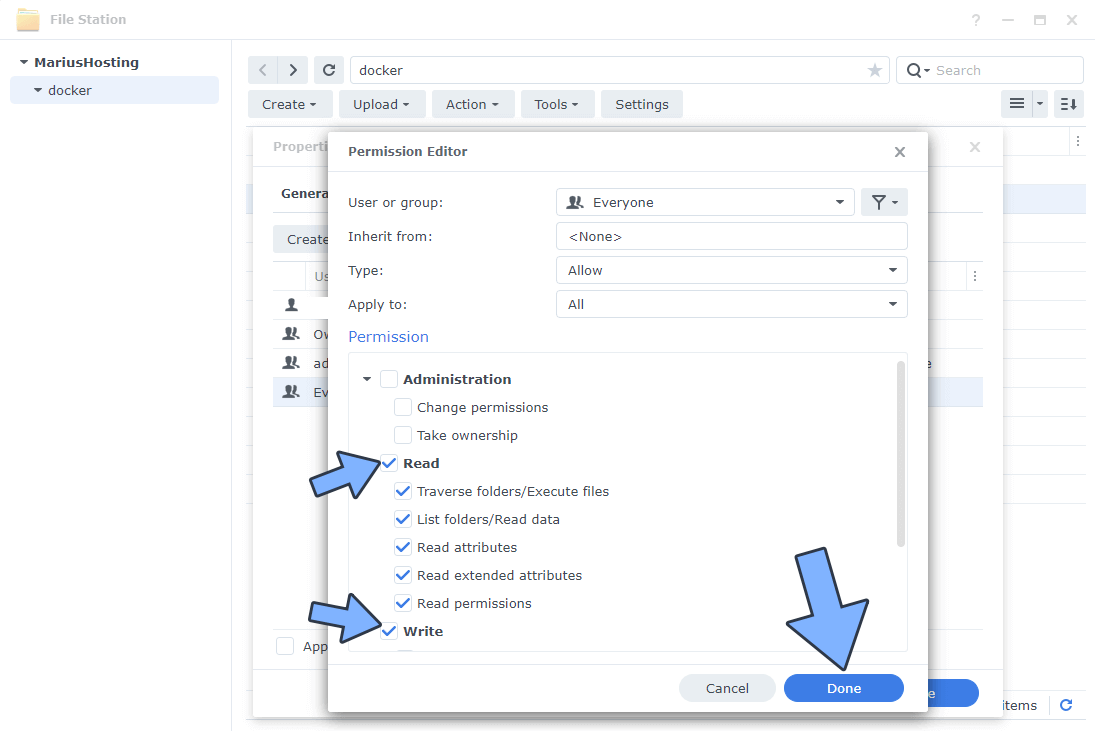
STEP 16
After you click Done on STEP 15, check “Apply to this folder, sub-folders and files“. Click Save. Follow the instructions in the image below.
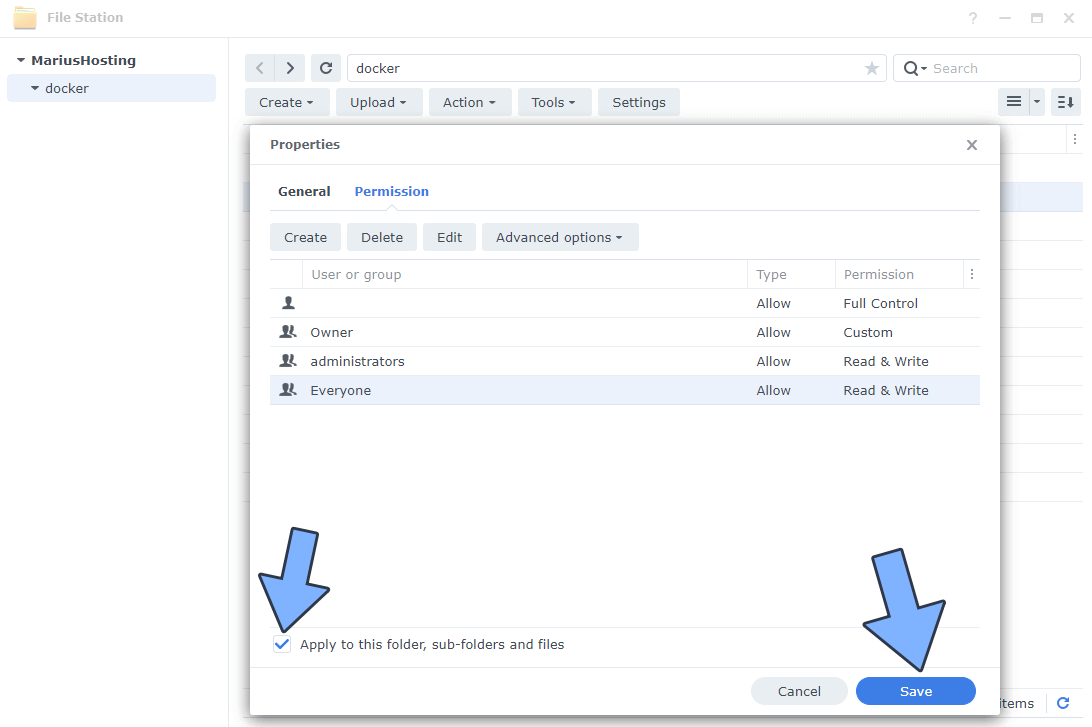
STEP 17
Follow my step by step guide on how to activate SMTP for your Gmail account. This step is mandatory. Note: If you don’t want to use the easiest way for SMTP with Google and you already have SMTP details from your own Mail Server, you can just skip this STEP and use your personalized email SMTP details instead.
STEP 18
Log into Portainer using your username and password. On the left sidebar in Portainer, click on Home then Live connect. Follow the instructions in the image below.

On the left sidebar in Portainer, click on Stacks then + Add stack. Follow the instructions in the image below.

STEP 19
In the Name field type in nocodb. Follow the instructions in the image below.
services:
db:
image: postgres:18
container_name: NocoDB-DATABASE
hostname: noco-pg
security_opt:
- no-new-privileges:true
healthcheck:
test: ["CMD", "pg_isready", "-q", "-d", "nocodb", "-U", "nocodbuser"]
timeout: 30s
interval: 10s
retries: 10
volumes:
- /volume1/docker/nocodb/db:/var/lib/postgresql:rw
environment:
POSTGRES_DB: nocodb
POSTGRES_USER: nocodbuser
POSTGRES_PASSWORD: nocodbpass
restart: on-failure:5
nocodb:
image: nocodb/nocodb:latest
container_name: NocoDB
hostname: nocodb
security_opt:
- no-new-privileges:true
healthcheck:
test: timeout 10s bash -c ':> /dev/tcp/127.0.0.1/8080' || exit 1
interval: 10s
timeout: 5s
retries: 3
start_period: 90s
ports:
- 8631:8080
volumes:
- /volume1/docker/nocodb/data:/usr/app/data:rw
environment:
NC_ADMIN_EMAIL: Your-own-email-address
NC_ADMIN_PASSWORD: Mariushosting@
NC_DB: pg://noco-pg:5432?u=nocodbuser&p=nocodbpass&d=nocodb
NC_SMTP_HOST: smtp.gmail.com
NC_SMTP_FROM: Your-own-gmail-address
NC_SMTP_PORT: 587
NC_SMTP_USERNAME: Your-own-gmail-address
NC_SMTP_PASSWORD: Your-own-app-password
NC_AUTH_JWT_SECRET: dOxZYTTZgXKMHkqLBIQVImayQXAVWdzGBPuFJKggzcgvgPJPXpWzqzKaUOIOGGIr
NC_PUBLIC_URL: https://nocodb.yourname.synology.me
NC_DISABLE_TELE: true
restart: on-failure:5
depends_on:
db:
condition: service_healthy
Note: Before you paste the code above in the Web editor area below, change the value for NC_ADMIN_EMAIL and type in your own email address.
Note: Before you paste the code above in the Web editor area below, change the value for NC_ADMIN_PASSWORD and add your own password. Mariushosting@ is an example for a password. You have to insert your own password. Your password should have at least 8 letters with one uppercase, one number and one special letter (Allowed special characters $&+,:;=?@#|’.^*()%!_-” )
Note: Before you paste the code above in the Web editor area below, change the value for NC_SMTP_FROM and type in your own Gmail address. Refer to STEP 17.
Note: Before you paste the code above in the Web editor area below, change the value for NC_SMTP_USERNAME and type in your own Gmail address. Refer to STEP 17.
Note: Before you paste the code above in the Web editor area below, change the value for NC_SMTP_PASSWORD and type in your own Gmail app password. Refer to STEP 17.
Note: Before you paste the code above in the Web editor area below, change the value for NC_AUTH_JWT_SECRET. (Generate your own Random 64 length NC_AUTH_JWT_SECRET.)
Note: Before you paste the code above in the Web editor area below, change the value for NC_PUBLIC_URL and type in your own synology.me DDNS with https:// at the beginning that you have previously created at STEP 6.

STEP 20
Scroll down on the page until you see a button named Deploy the stack. Click on it. Follow the instructions in the image below. The installation process can take up to a few minutes. It will depend on your Internet speed connection.

STEP 21
If everything goes right, you will see this message at the top right of your screen: “Success Stack successfully deployed“.

STEP 22
🟢Please Support My work by Making a Donation. Almost 99,9% of the people that install something using my guides forget to support my work, or just ignore STEP 1. I’ve been very honest about this aspect of my work since the beginning: I don’t run any ADS, I don’t require subscriptions, paid or otherwise, I don’t collect IPs, emails, and I don’t have any referral links from Amazon or other merchants. I also don’t have any POP-UPs or COOKIES. I have repeatedly been told over the years how much I have contributed to the community. It’s something I love doing and have been honest about my passion since the beginning. But I also Need The Community to Support me Back to be able to continue doing this work.
STEP 23
Now open your browser and type in your HTTPS/SSL certificate like this https://nocodb.yourname.synology.me In my case it’s https://nocodb.mariushosting.synology.me If everything goes right, you will see the NocoDB SIGN IN page. Type in your own E-mail (NC_ADMIN_EMAIL) and your own Password (NC_ADMIN_PASSWORD) that you have previously added at STEP 19 then click SIGN IN. Follow the instructions in the image below.
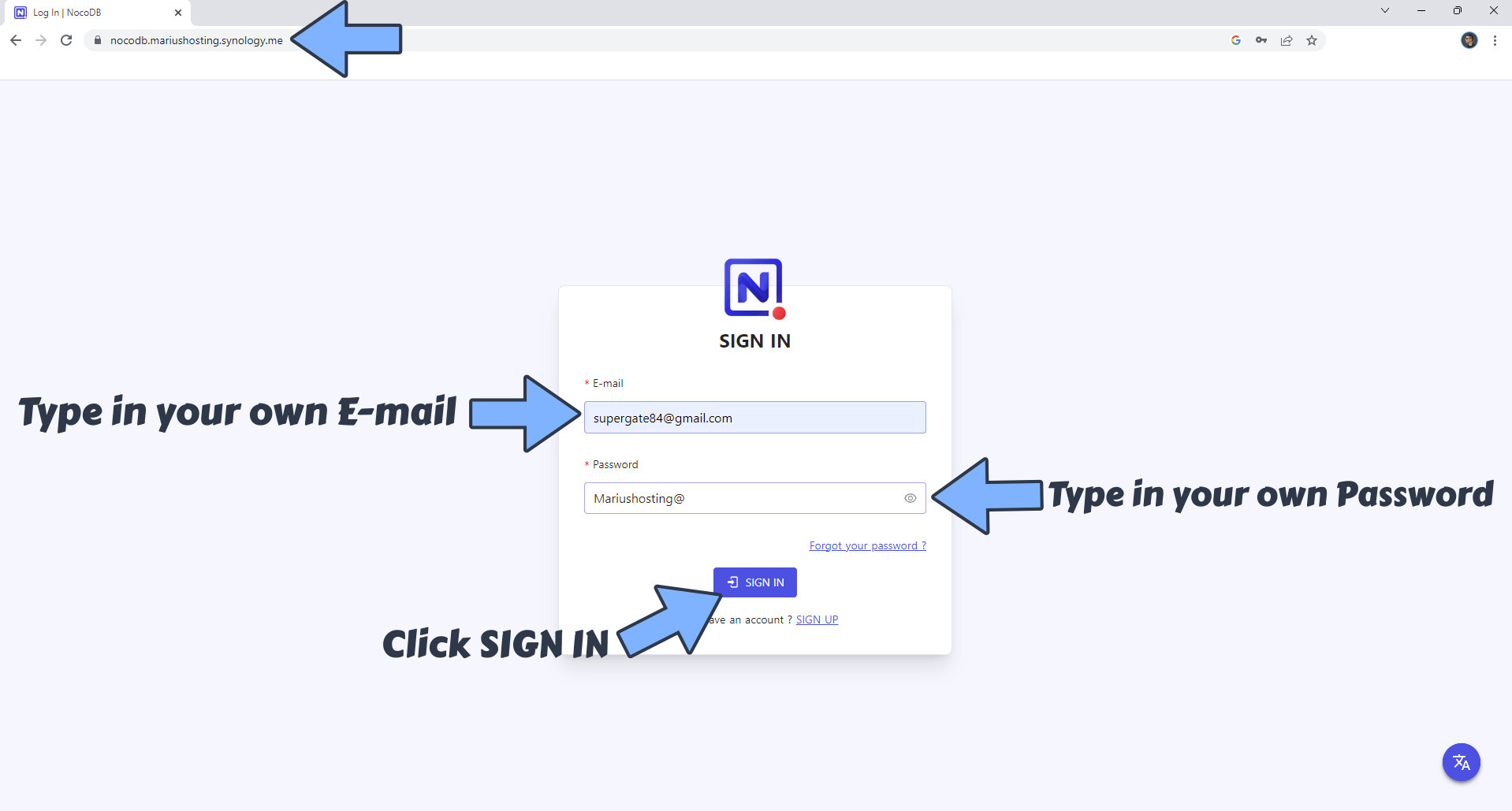
STEP 24
Now you can create your New Base! On the left sidebar, click + Create Base. Type in your own Base name, then click Create Base. Follow the instructions in the image below.

STEP 25
On the left sidebar, click Overview to check your Base that you have previously created at STEP 24. Click the Members tab, then + Add Members. Follow the instructions in the image below.
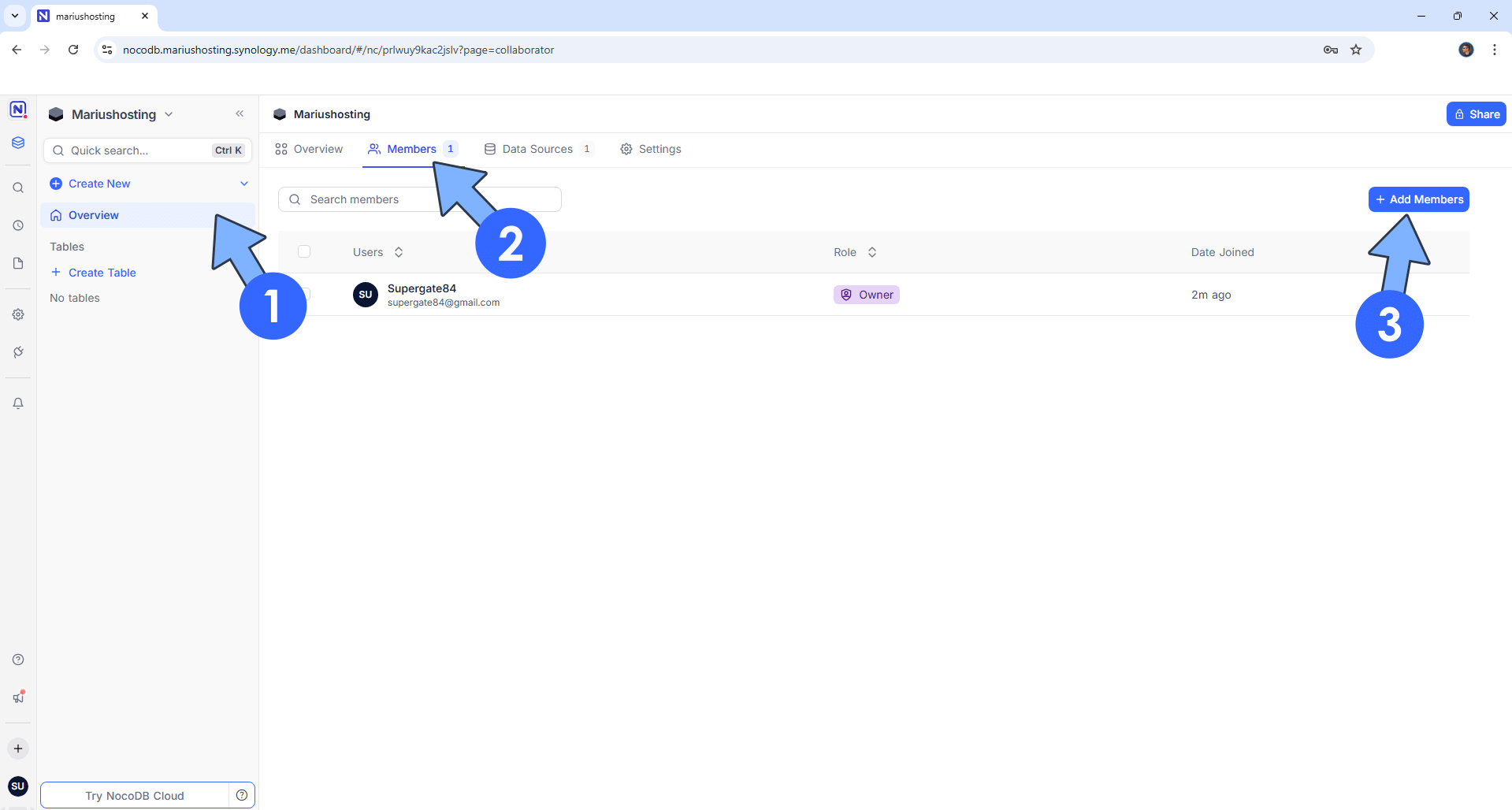
STEP 26
Type in the email of the user you want to invite. Select the User Role, then click Invite to Base. Follow the instructions in the image below.
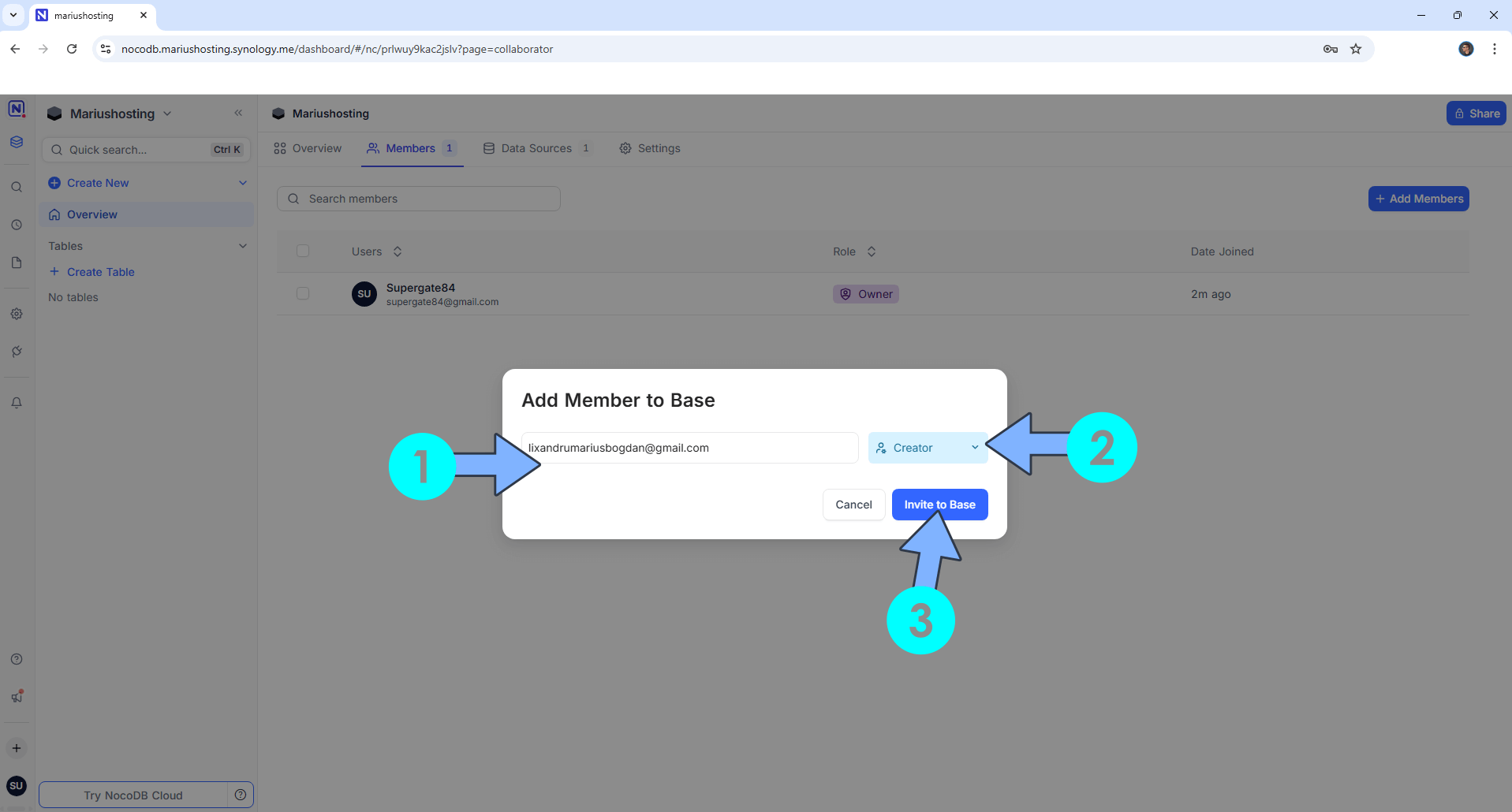
STEP 27
The user will receive an email. If they click Accept Base Invite, they can join your team.
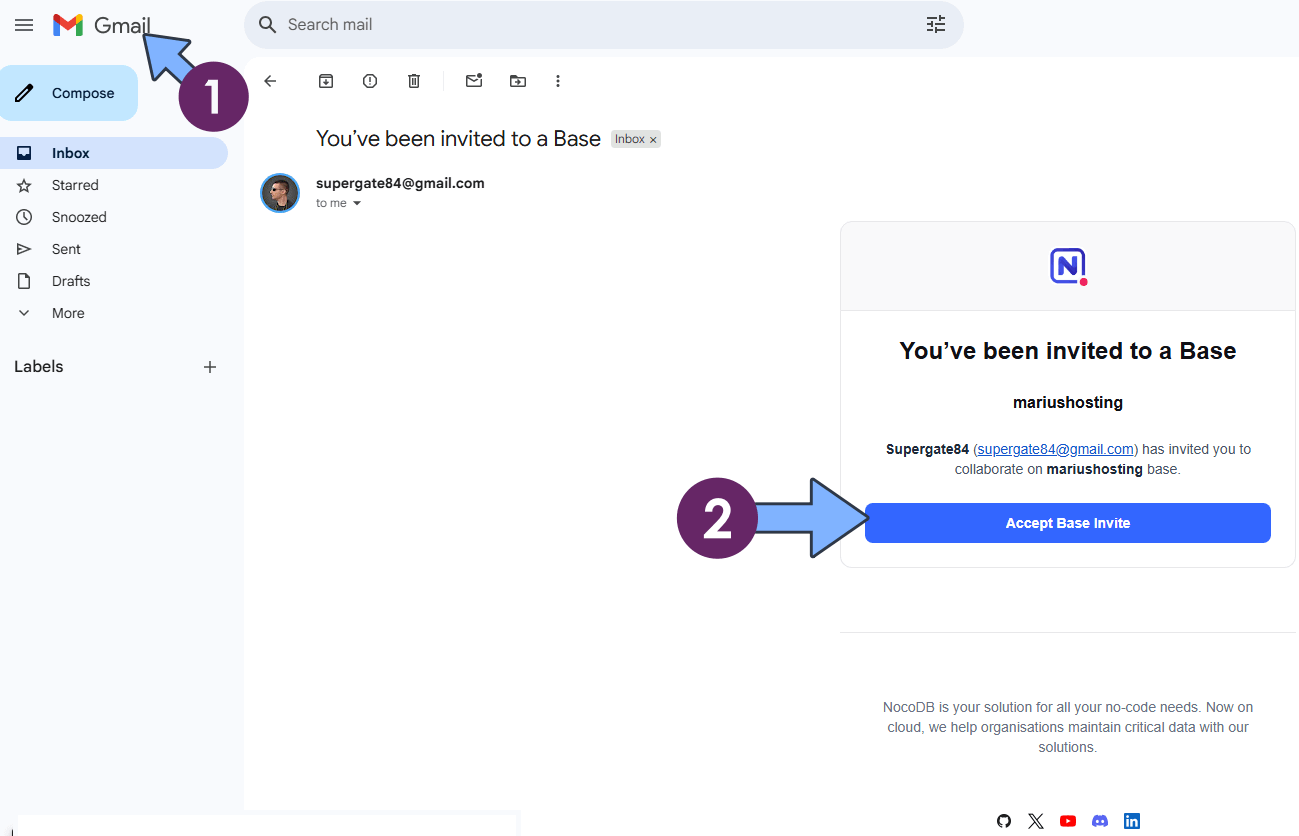
Enjoy NocoDB!
If you encounter issues by using this container, make sure to check out the Common Docker issues article.
Note: Can I run Docker on my Synology NAS? See the supported models.
Note: How to Back Up Docker Containers on your Synology NAS.
Note: Full NocoDB Environment Variables.
Note: Find out how to update the NocoDB container with the latest image.
Note: How to Free Disk Space on Your NAS if You Run Docker.
Note: How to Schedule Start & Stop For Docker Containers.
Note: How to Activate Email Notifications.
Note: How to Add Access Control Profile on Your NAS.
Note: How to Change Docker Containers Restart Policy.
Note: How to Use Docker Containers With VPN.
Note: Convert Docker Run Into Docker Compose.
Note: How to Clean Docker.
Note: How to Clean Docker Automatically.
Note: Best Practices When Using Docker and DDNS.
Note: Some Docker Containers Need WebSocket.
Note: Find out the Best NAS Models For Docker.
Note: Activate Gmail SMTP For Docker Containers.
This post was updated on Friday / December 19th, 2025 at 4:17 PM
